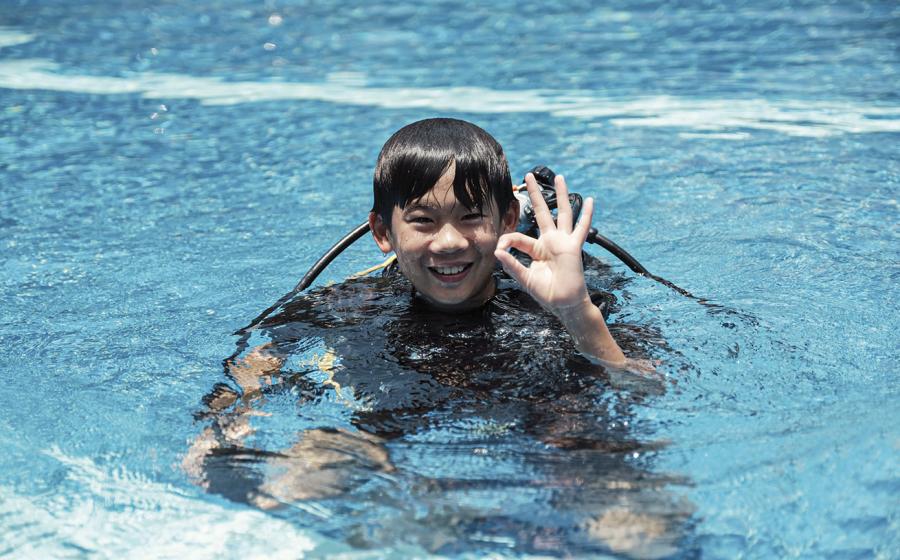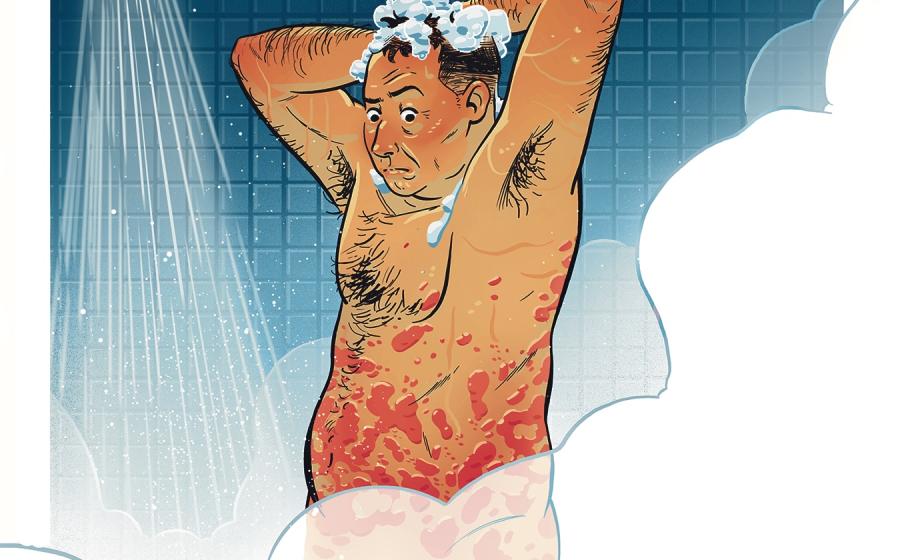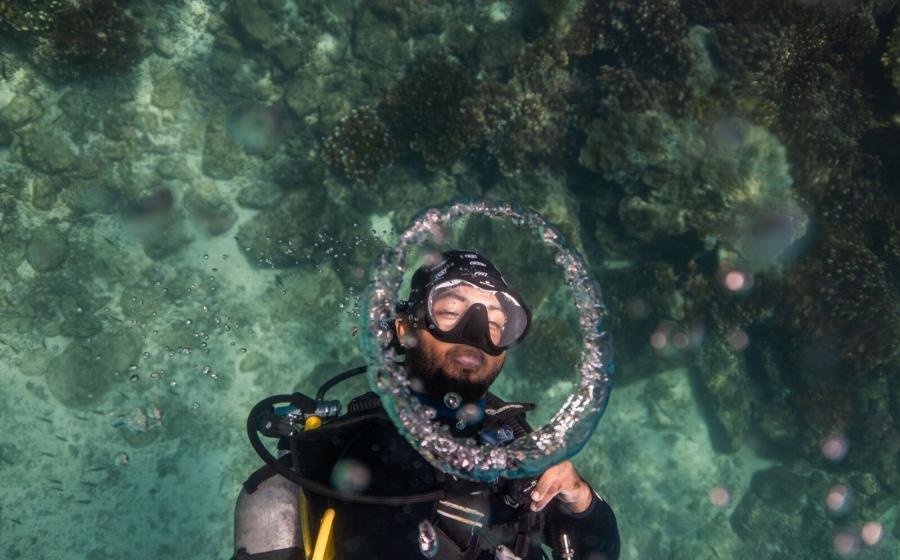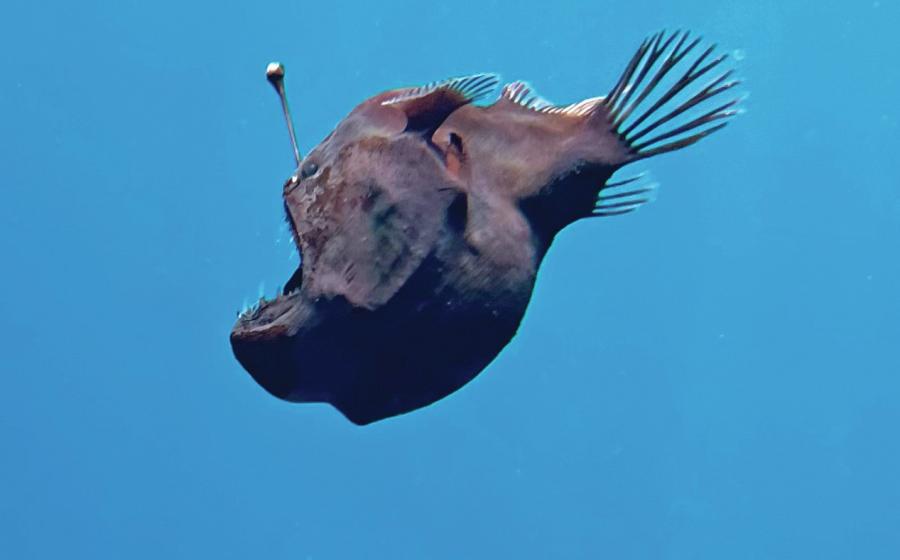Carrie Manfrino Dives in to Coral Restoration in Little Cayman Island

Carrie ManfrinoOceanography professor and scientist Carrie Manfrino has been studying coral reefs for years, and hopes to inspire others to help protect these ecosystems.
Learn how to volunteer with Carrie Manfrino at the Little Cayman Research Center.
Is there anything you’ve learned through your work with Little Cayman Research Centre that gives us hope for the future of coral reefs?
Absolutely! We’ve learned that even though corals have declined over several decades, there are also waves of young corals that naturally replenish reefs. After the 1998 El Niño event that killed corals across the planet, we saw major losses in coral cover for six years. During that time, corals were dying from diseases and temperature stress. Now, we have reports of corals recruiting from a variety of locations including northwest Australia and the Caribbean at Little Cayman. We are also able to trace the early-life history of young corals by tagging them and revisiting them annually to examine whether they are surviving. The great news is that corals are surviving at Little Cayman, which offers enormous hope for the future.
Throughout their long-term history — and I mean millions of years — coral reefs have survived episodes of major climate change; they even survived the extinction event that killed the dinosaurs. We also know that coral species that lived 2 million years ago are the same species dominating reefs in the Caribbean today. The important message is: Although climate change is incredibly stressful, our work at Little Cayman demonstrates that corals are capable of surviving if other local stress factors can be reduced or minimized.
For a hopeful, albeit scientific, coral reef story read “A Positive Trajectory for Corals at Little Cayman” (Manfrino et al 2013) available in PLOS One, an open access journal.
There’s global enthusiasm for creating protected marine parks these days; you’ve been researching whether marine parks are capable of protecting coral reefs — is there an answer to that question?
Marine parks are absolutely fundamental to protecting coral reefs. They also need to be expanded well beyond the current areas. It is my belief that the island and coastal communities that rely on healthy ocean ecosystems play a significant role in regulating their parks. What we’ve learned is that when a global event like the 1998 El Niño occurs, corals are among the most vulnerable creatures in the ocean.
Marine parks provide an added level of protection for coral reefs and are incredibly important for reducing levels of stress from humans. They protect fish when they are no-take reserves. They protect the habitats where both predators and herbivores are striking a balance, which is critical for the whole ecosystem to remain intact.
We used a provocative title for a publication in 2007 suggesting that “Marine No-Take Areas Are Not Enough” to save corals and coral reefs (Coelho and Manfrino, 2007). What we were demonstrating, after almost a decade of studies on the reefs surrounding the Little Cayman Research Centre, was that corals were vulnerable and threatened by global stressors whether they were inside or outside the boundaries of marine parks. The level of protection and areas protected that are being proposed by NGOs and scientists are still not enough for reefs to be sustainable. As divers, we need to ask our governments and resort and dive-club owners to support any local efforts to increase marine protection.
The Little Cayman station you helped create is used for long-term environmental monitoring, among other things; what does “long-term” mean here, and what has been learned from that?
The kind of data that I am speaking about is rarely available, but at Little Cayman, we now have a record of coral health starting in 1999. So, long-term for me in this instance is long enough to establish a real trend in the data. At least decades.
My serious concern about modern reefs began in1999 after a heartbreaking field season on Grand Cayman when all of the corals in my study area were dead! With my two very young daughters in tow, I had to ask myself what was in store for the children of the world who are still too young to see what I had experienced. This single event was actually the impetus for me to establish the Central Caribbean Marine Institute.
By 2003, the Institute was well established, but we needed a place where scientists and students could work to begin disentangling short-term human impacts from longer-term natural change on coral reefs. My rationale was that if we wanted to understand the factors that would lead to coral reef survival, we would need a place where human influence was minimal. Marine laboratories like the Little Cayman Research Centre place scientists on the front lines of understanding and managing environmental change. We maintain and make it possible to study environmental processes at multiple spatial and temporal scales. So a new research institution is an important, complex resource that, hopefully, effectively communicates the changes at particular locations. We also have the responsibility of explaining the longer-term effect these changes may have on humanity. Our vision at CCMI is to increase global interest in protecting the future of coral reefs.
When the Little Cayman Research Centre was completed in 2006, my vision was to also add value to the world of coral reef science. I felt it was important to establish a long-term monitoring system, which led to a partnership with NOAA’s Coral Health and Monitoring Program. NOAA offered the engineering and infrastructure required to continuously monitor the ocean. In 2009, NOAA and CCMI installed the first international and independently owned Coral Reef Early Warning System, or CREWS, just offshore from the Little Cayman Research Centre. The instruments were attached to a permanent pylon that was snapped in two when Hurricane Sandy passed to our north east in 2012. Last year, we installed a more robust buoy. All of these investments are leading to important discoveries about how the ocean heats up and is helping us calibrate satellite information about the ocean. We’ve learned that not all coral reefs become stressed at the same temperature threshold. For Little Cayman, that temperature is 85 degrees Fahrenheit for just over four weeks. The alarm sets off and we begin looking for signs of stress.
What else have we learned? We have learned that some coral reefs are capable of recovering, even after multiple coral bleaching or temperature stress events.With minimal local stressors, corals can recover from global events — at least for now. Corals are reproducing and young corals are surviving; corals are expanding here. This tells me that the crystal-clear water surrounding the Caribbean Islands is still capable of sustaining coral growth; we need to do everything to protect reefs and not give up hope. We just need to understand why some reefs are regenerating while others are not so we can tell the rest of the world.
Why is it important to make Cayman kids “ocean literate" by age 12?
I chose 12 years old because this is an impressionable age, and at this age, children can also make a major difference to improve the future for our oceans. In Cayman and other Caribbean nations — despite the historic importance of fishing to local economies and cultures — local people are surprisingly detached from the ocean ecosystem. Two decades ago, there were almost no Caymanian divers, and many live their entire lives without learning to swim. With coral reefs seriously declining, I felt that young children in the Caribbean, whose natural heritage is tied to the sea, were not being exposed to coral reef conservation. That’s changing fortunately.
I’ve always felt incredibly fortunate to be an oceanographer and have my daughters with me for almost every field season from the time they were babies. They became snorkelers as soon as they could float and then became divers when they reached certification age. They love the ocean and have had the opportunity to experience coral reefs with thriving fish populations, turtles and colorful, diverse corals.
The Ocean Literacy campaign was launched in 2007 as an effort to increase the understanding and stewardship of coral reefs. We’ve been able to offer scholarships to hundreds of children.
When it comes to education, we actually take a global approach. At the Little Cayman Research Centre, we also have projects and courses that international high school and college students can participate in during the winter and summer sessions. Our Caribbean Marine Ecology Camp is an opportunity for high school kids to learn about coral reefs, and they also become great divers.
Your resume is incredibly varied; it’s hard to focus on just one thing: What’s the most fun thing you’ve done underwater?
One of the most exciting, fun experiences I have had was with a pod of killer whales that were traveling down the south side of Little Cayman. There were at least six babies, and [the adults] allowed us to stay within a few feet for almost the entire length of the island. When we reached the west side of the island they departed for the open ocean.
It is hard to fathom that my work requires that I dive on tropical coral reefs. How much more fun could you have than that? Every time I sink beneath the ocean’s surface, I fly, free as a bird, underwater.
How can everyday divers and Scuba Diving's readers help further the work you are doing?
Most critical is to be good divers: maintain good buoyancy well above any live organisms that are attached to the seafloor. The sea fans, branching corals, and even tube sponges are all susceptible to breakage. When a storm comes through, these organisms naturally get pulled from the sea floor; they will regenerate, and some of them grow very rapidly. What is important is that we allow nature to regenerate. Large sea fans can be 100 years old. All of these organisms are filter feeders, so they play a serious role in keeping the water surrounding coral reefs healthy.
Divers must also bear witness to the marvels of a healthy living ocean. We experience wonders that others only see on TV. We need to translate the passion that comes from diving into awareness and commitment to conserving it.
Motivated divers and snorkelers can also advance the science. My colleague Dr. Kristi Foster and I have just become Earthwatch scientists, and we will begin a new project to document endangered corals in the Caribbean. This is a project for snorkelers, but this winter, CCMI will have a program where recreational divers can help photograph EDGE (Environmentally Distinct and Globally Endangered) and threatened coral species. Dive clubs or divers with their buddies should contact [email protected] if they are interested.
We’ve also launched a project for divers to directly support our Protecting Reefs for the Future campaign.
What's next for Carrie Manfrino?
What is next for me is to work toward achieving the mission of the Central Caribbean Marine Institute, which is to protect coral reefs for the future.
The projects that I am working on next (and now) are aimed at strengthening our understanding of what contributes to coral recovery and will also work to reinforce discoveries that restore the balance of coral reefs. Also, the work has to engage children and our community in active coral reef conservation as a part of our Science and Society Initiative.
Thanks to the Darwin Initiative’s goal to specifically improve the biological diversity of nature in the U.K Overseas Territories, I am working on a project to reduce the loss of coral diversity. The project includes working to multiply stocks of certain threatened species. This work is in an experimental stage and we are learning that finding the best habitats for new corals to grow is tricky. We need a better understanding of why certain species prefer specific locations on reefs. So, over the next two years, we will work with Earthwatch citizen scientists who will help us create detailed maps and models of coral communities (on a small and large spatial scale). As part of this project, we want to understand how different stressors will impact different corals. We are conducting simulations of future predictions of ocean acidification in experimental tanks at the research institute. What we should learn is whether certain species might be more capable of adapting to lower pH conditions. These species should be ranked highly on the list of protected corals.
I am fortunate that CCMI has received two recent National Science Foundation awards, one to build a new laboratory to enhance our understanding of coral reef stress and one to fund a Research Experience for Undergraduates (REU) on coral reef biodiversity and resilience. Now that the lab is done, I am exploring new funding to support work to understand why some reefs are dying while other reefs, like those at Little Cayman are recovering. Understanding mechanisms driving coral recovery may be the most important key to protecting reefs for the future.
Finally, I am planning to install a new instrument at the NOAA CREWS buoy which will begin directly measuring the amount of carbon dioxide increase in the ocean. We want to broadcast a direct signal of the rising gas from the middle of the Caribbean and from coral reefs that are still thriving. The information will be readily available at our website. I’d like to think it would be a clear demonstration of our connection to the sea. It would be my hope that everyone would begin to recognize that we are all linked to the ocean and that each and every individual contributes to making the planet sustainable (or not).
What would you do with the $5,000 Oris award if selected for Sea Hero of the Year?
I’d love to buy electric scooters for the Little Cayman Research Centre staff to drive on short trips. The Institute is in an isolated corner of a sparsely populated island. Gasoline is extremely expensive, and our researchers often face challenges getting around. I am pushing for increasing the already ambitious sustainability program for the Institute, so the scooters will offer a major element for our current plan. With the scooters our team members can pick up and deliver lionfish for our studies and for our community, and they can use them for short trips to town — maybe even for shore diving at our study sites.
We built the first off-the-grid building in the Cayman Islands back in 2005, and by the time this issue is released, we also will have just finished installing the first solar car-port. We can charge up the island’s electric vehicles and our new scooters! We would be incredibly proud to promote ways [in which] small islands and coral reefs can be reduce their CO2 footprint.
What else would you like readers to know about? Tell us what's on your mind!
As much as I love corals, fish on reefs need to be protected. Reef fish maintain the balance on coral reefs. Protecting parrotfish and all fish that live on and around coral reefs is a great step toward protecting reefs for the future.
Reducing human consumption is really on my mind because its knock-on effect can reduce many other issues. Finally, local efforts, no matter how small, can result in changes that really make a difference. You can change the world.
Learn more about Sea Heroes, and view all past recipients of the award










